A year ago today, the Flagstaff Fire roared across the mountaintops at the western edge of Boulder. Down below, we anxiously followed the plume of smoke, tracing the widening circle of flames across the peaks. Was this the big one, the fire that would catapult itself on the wind down into the city? Aggressive fire response from all departments in the region laid our fears to rest. The fire smoldered and burned out, and no embers skipped into town.
Seven weeks later, Dave Sutherland toured the fire zone and offered this photo essay. Even after only seven weeks, some plants had roared back, not only sprouting leaves but also in that short time sending out flowers, which attracted insects, who in turn attracted birds. Woodpeckers were busy combing blackened bark for roasted bugs; new life was flourishing in the fire zone.
It’s been a year, and how does the fire zone look now? Recently I had the rare treat of seeing the mountaintop without enduring most of the climb to get there. Dave organized a special hike for nature educators, driving us up almost to the edge of the burn area.
On our way up the mountain we stopped along one of the fire roads and took a look from a distance at the burn. Even on a hazy morning we could see that the fire had traveled a Y-shaped path up the west ridges of Bear Peak, on the left, and South Boulder Peak on the right. The saddle between the two mountains saw much less fire and remains green.
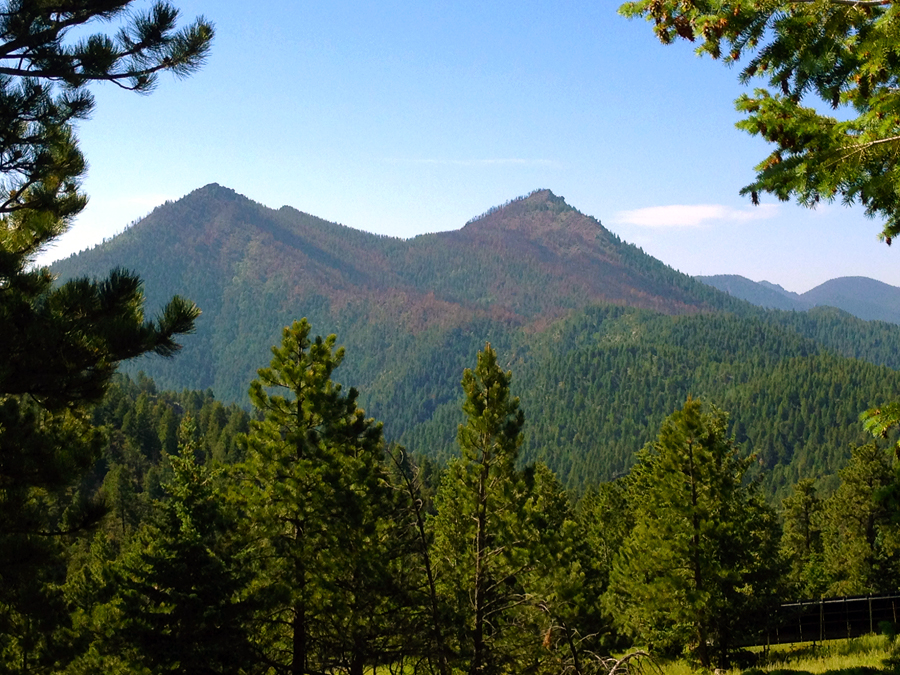
Fire loves to go uphill because the heat rises ahead of the flames, parching the ground and preparing it for combustion. Once the flames crest a hill, they have a much harder time moving down the other side, which is why a year ago today, Boulder faced a larger danger by far from wind. Gusty winds could have deposited embers in the heart of town; it was a lot less likely that the fire would march straight down the Flatirons.
Near the fire zone, we climbed out and admired the carpet of blue mist penstemon.
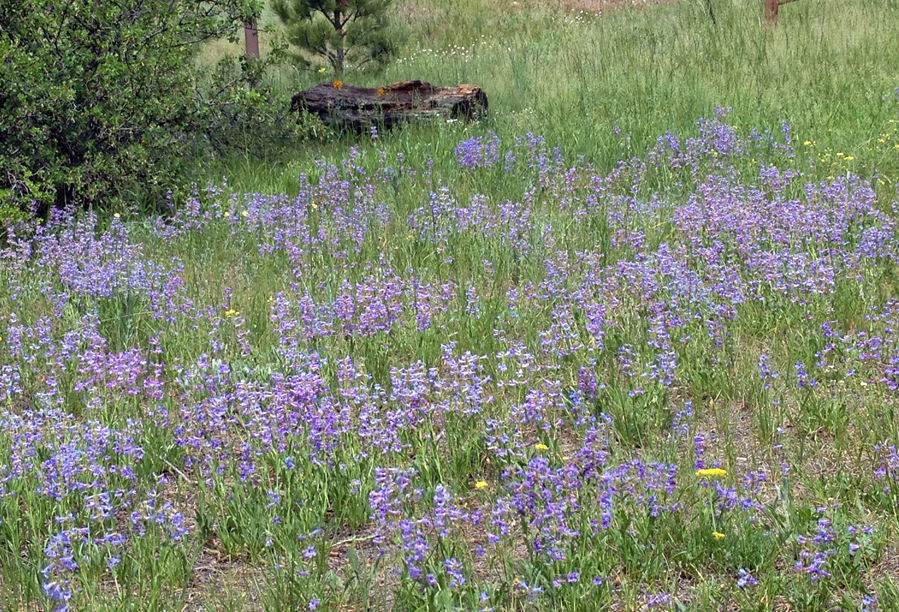
The scene changed just a short distance up the hill. Inside the fire zone, penstemon were blooming again, but only a few of them. Penstemon roots are 6–9″ long, which shows that the fire was not hot enough in this particular spot to disturb the roots of every plant.
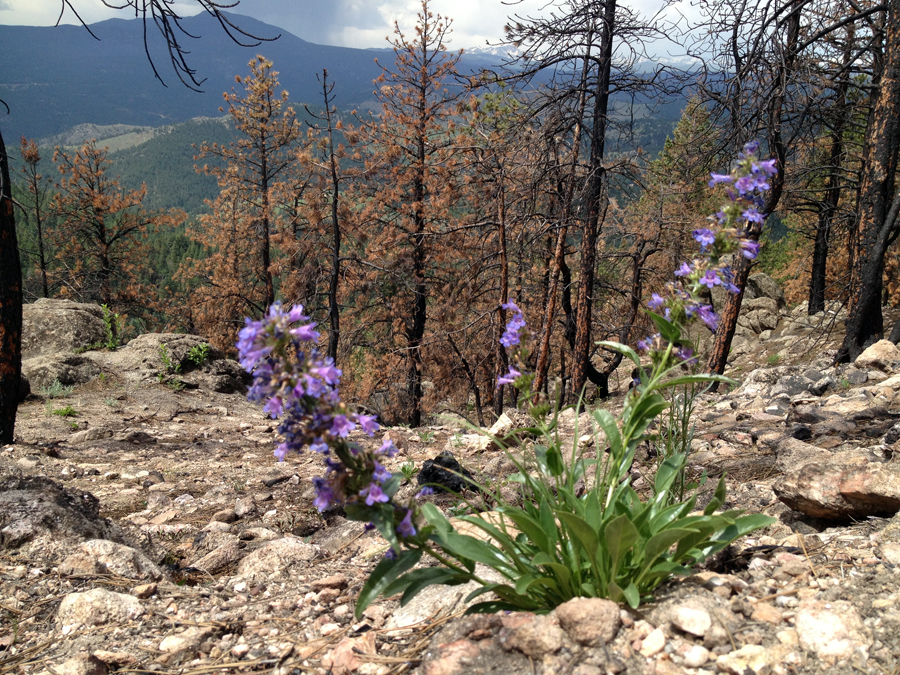
Yet turn around, and we saw behind us two holes in the ground—only a memory of two young ponderosas. In this spot, the fire blazed hot enough to vaporize even the roots of the trees. Each cavity is now adorned with a sprig of the invasive prickly lettuce.
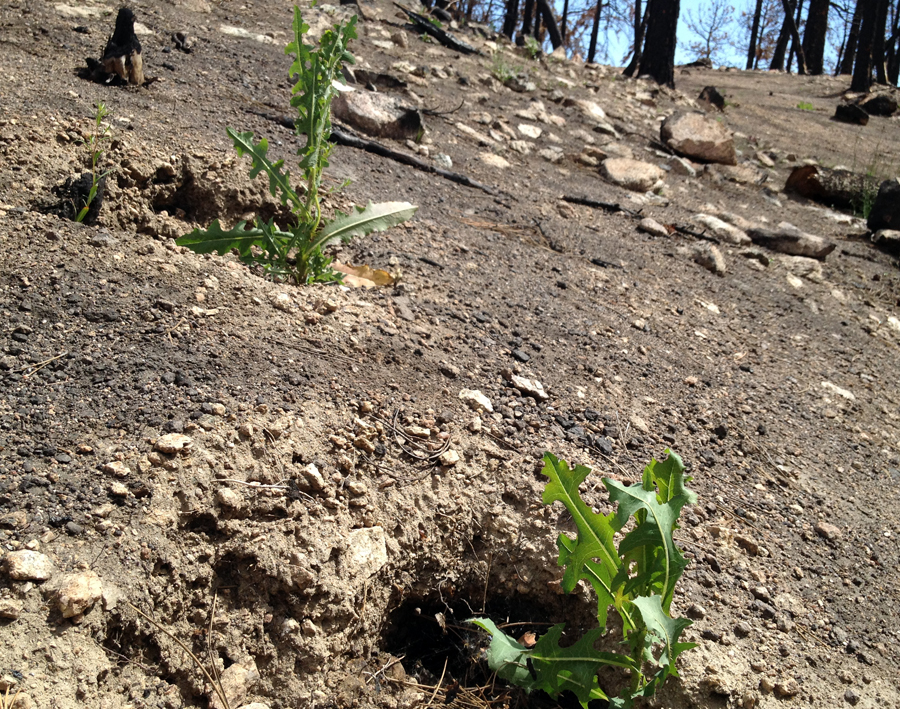
If the ground looks charred, it also shows a great deal of fresh green. Much of the earth is covered with a patchy layer of new plants and flowers.
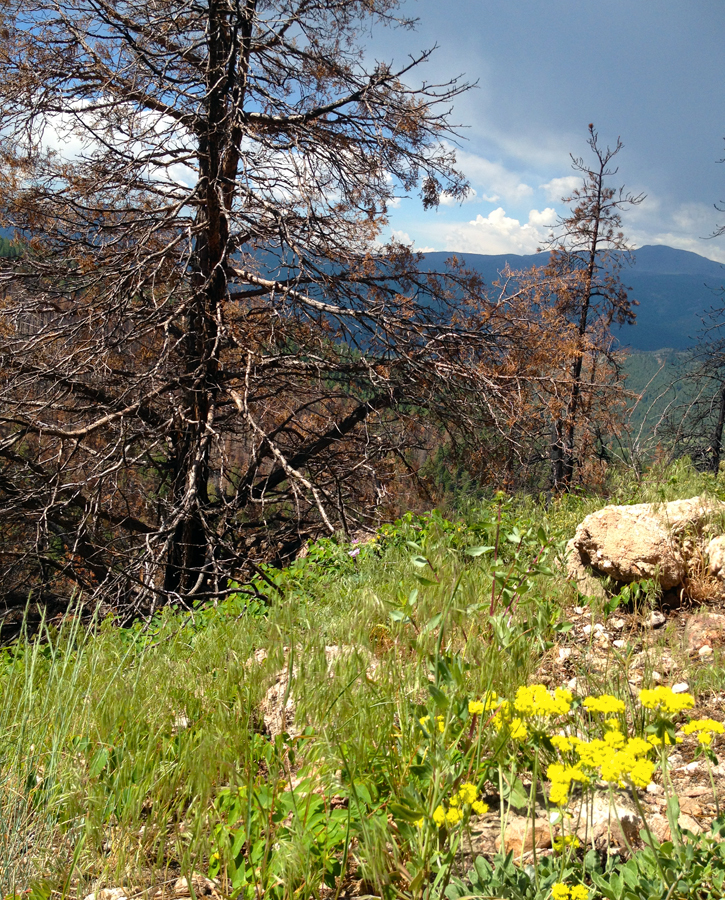
Perhaps my favorite from the morning was golden smoke (Corydalis aurea), the only flower of its family to grow in Colorado. Before the fire, golden smoke was not common around here. Now it is springing up everywhere in the fire zone. It prefers light shade and forest clearings, which explains why when this forest was cleared by fire, golden smoke seized the day.
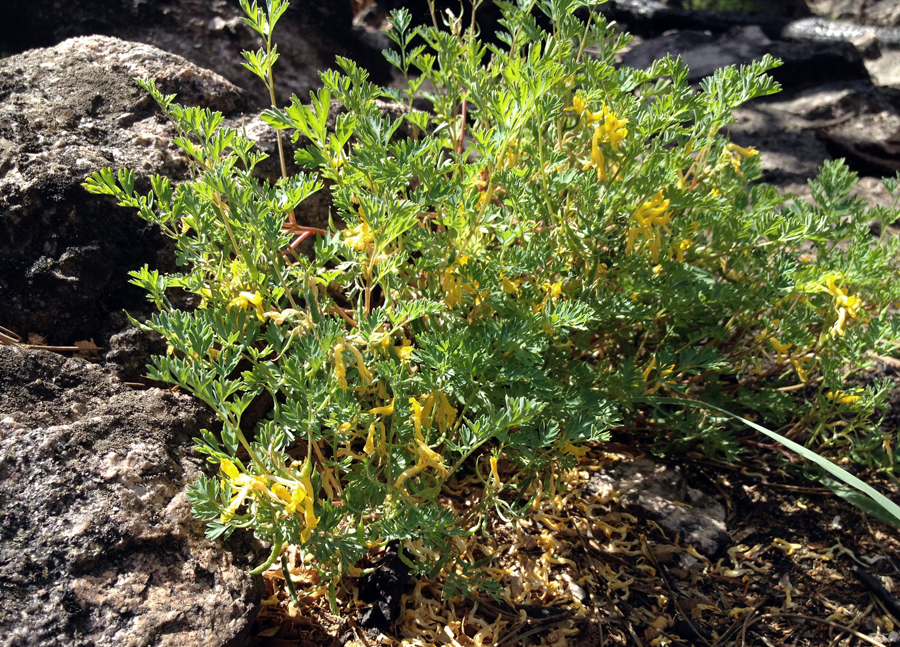
Dave pointed to a blackened ponderosa pine. “See the patchwork on the bark?” he asked. “Woodpeckers do that.” After a fire, he explained, woodpeckers pick a spot on a burned trunk and get busy, flipping pieces of bark left and right as they search for bugs underneath. Pretty soon the blackened tree is a mosaic of black and tan.
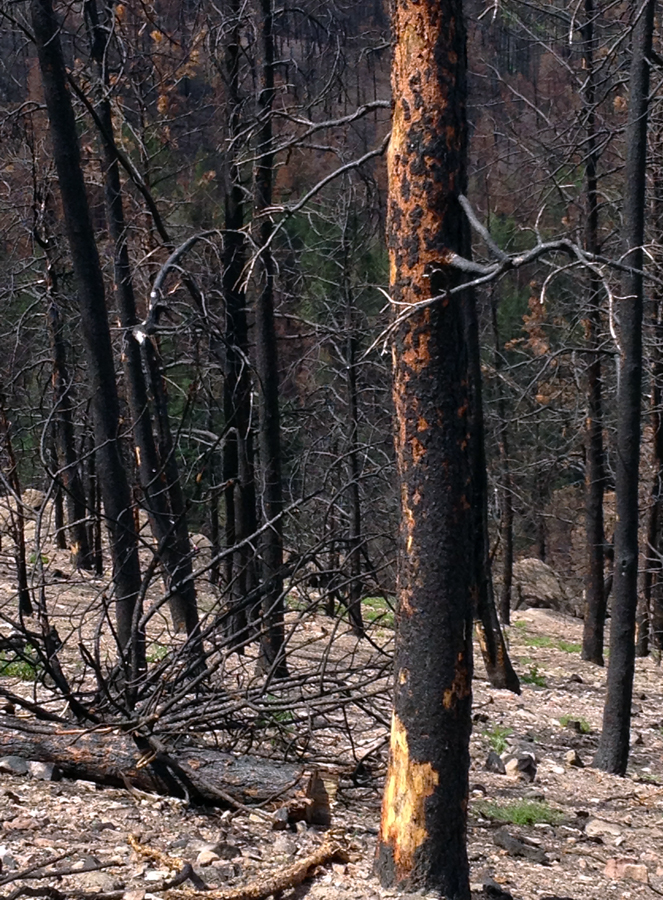
Perhaps the biggest message Dave wanted us to take home was the patchwork nature of a forest fire in general. “Look out on that burn area,” he urged. We looked out on a variegated scene. Browned and blackened trees alternated with live stands of ponderosas as far as we could see.
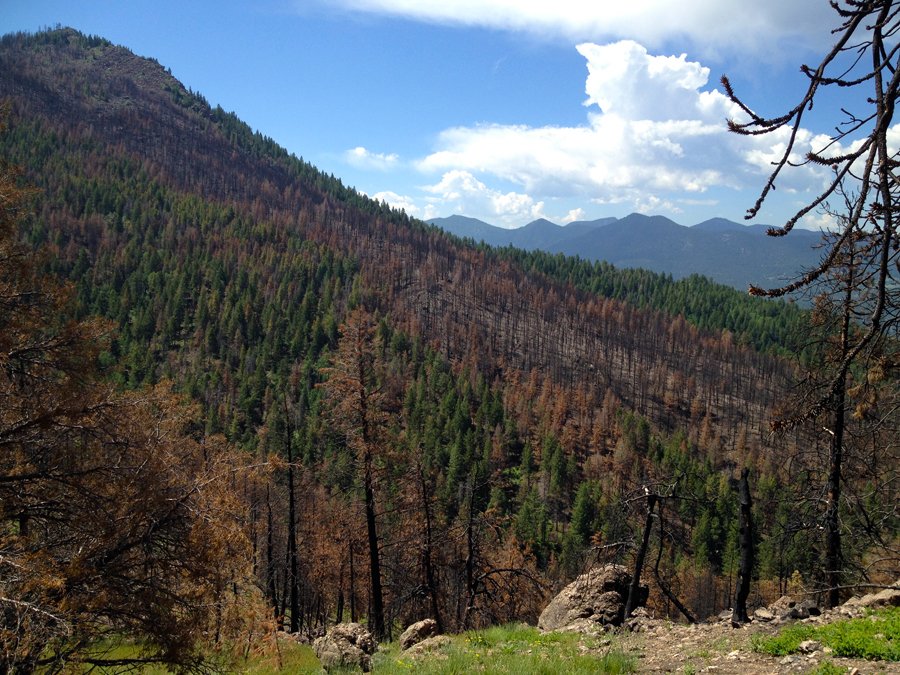
“A forest fire helps biodiversity,” he said. “It opens up areas of the forest floor that have been shaded for decades. And it releases some species to grow in places where they have not grown for years.”
He pointed to a tiny clump of aspen hugging the ground. “Aspen trees have been crowded out of this hillside by ponderosa shade for the past sixty or seventy years. Now the ground is opened up, and the aspens have a chance to repopulate this hillside. In another decade this side of the mountain will likely be covered with aspen.”
Because the effects of a fire are spotty, a fire in a ponderosa forest reduces the monoculture of the forest, encouraging new species of plants—and therefore insects and birds and animals—to emerge. A fire supports nature’s endless thirst for variety. And since a diverse landscape is usually a more resilient one, a forest fire promotes the long-term health of the local ecosystem.
I’ve met people who can’t bear to walk in a burned forest. It’s too painful, they say. No green to look at, only the ruined skeletons of trees. I have a different view. A burned forest may not refresh like a green one, but a burned forest tells a story—a story of change and opportunity, a story of starting over that may appeal if you’re a pioneer. It’s a story I find as enlivening in its own way—and a lot more bracing—than the nourishing beauty of lush green land. In a burn zone, one walks the knife edge between life and death.
But like the desert, a burned forest is best taken in small doses. That morning our hike was cut short by threatening clouds and rumbling thunder. Instead of remaining near the peak of the mountain to tempt lightning, we retreated below to sit and talk among the penstemon.
Leaving the charred forest early was fine with me. I felt relieved to get back among green things, to breathe deeply and relax.
And I was grateful all over again that a year ago today, the wind did not carry embers on that very short path into the town below.
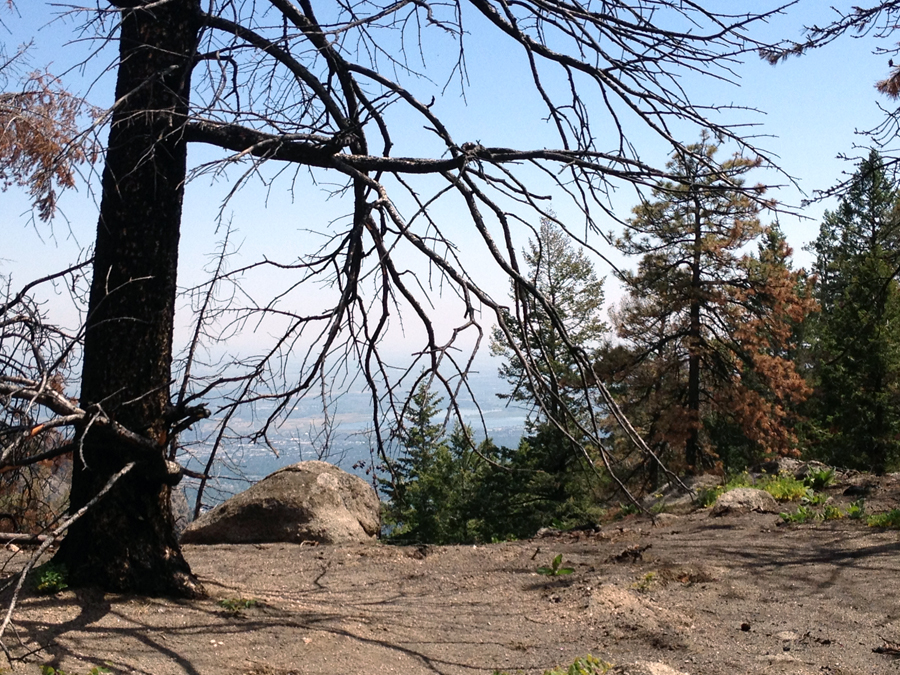
This is a beautiful photo essay, Priscilla, and gives me hope about the recovery of the ecosystem. You are so knowledgeable, and eloquently share what you know and intuit. I’ve experienced the stunning quiet of a burnt forest, as well as the power of nature to renew itself.
Thanks, Gail. Yes, a freshly burnt forest is shockingly quiet. But it hardly takes any time at all for the critters to move in and scavenge and rebuild. And after a year, the only difference in sound I could hear was the absence of wind in pine needles. The breeze sounds different among the burnt trees.
Thanks, Priscilla. Great post about one of my favorite subjects, “the knife edge between life and death,” as you put it so succinctly. I think this is one of the most important subjects our culture needs to revisit and remember, and you are an excellent teacher.
Thanks, Linda. It’s unsettling to walk in a fire zone, the way injury and change are unsettling. One has to keep breathing, to remember to breathe, and to be open to seeing what new forms of life present themselves.
Sounds a lot like life itself!
That’s for sure! Just more obvious than in the rest of life.
“Nature’s endless thirst for variety.” That is a strangely comforting statement. Thanks for the tour of our mountainous backyard.
I find it comforting too, Barbara. Endless variations on a theme, boundless creativity. Good to remember when walking through a burned landscape.
Lovely essay!
Thanks, Dave! And thank you for arranging the hike. And for stopping partway up the hill. I like having the distant view of the fire zone in here too.
What a beautiful and timely essay. We cut short a visit to Crestone last weekend because of the choking smoke from the Wolf Creek fire. On the drive home I carped about the Forest Services’s decades-long policy of fire suppression, one of the many causes — along with drought and beetle kill — of our current nasty predicament. Your essay reminded me that wildfires are just one more “circle of life” event, clearing out the old to make way for the new. You helped me realize that the question isn’t how to prevent wildfires, but how to live with them well. If it’s true that allowing forests to occasionally burn increases the health and diversity of the whole ecosystem (including lessening the chance of “super fires”), I guess we’ll need to learn to make friends with smoky summer skies — and to make smarter choices about where we build our homes. The thought of seeing Aspen groves in the Boulder foothills softens the blow.
Thanks, Jeff! Yes, I’d be happy with small, ground-hugging forest fires, the way they would happen if they were allowed to burn every dozen years or so. Houses wouldn’t be in danger, especially if they were arranged in smarter clusters. The policy of fire suppression for the past hundred years has really put communities in danger. It turns out, though, that beetle kill is likely not a factor in increased fire activity. “The most flammable forest is a green one,” says my forest ecologist friend who has studied pine bark beetles. Why? Because a green forest has flammable sap running through every tree. Once a section of forest dies and this flammable fuel retreats, trees can no longer explode and send sparks to their neighbors, and a fire has a harder time spreading.
Hi, Priscilla! I was very surprised to read what your forest ecologist friend said — that beetle kill “is likely not a factor in increased fire activity.” I did a little sleuthing on the web and found a research paper on “Potential Fire Behavior in Spruce Beetle-Induced Tree Mortality in Intermountain Spruce-Fir Forests”
(http://digitalcommons.usu.edu/barkbeetles/205/). I’m not sure if the results of this study are universally applicable, but the researchers found that “fireline intensities ranged from 4.1 – 5.0 times higher in the epidemic condition class (beetle-infested forests) and 6.6 – 8.8 times higher in the post-epidemic condition class compared to endemic condition class (non-infested forests). That’s more along the lines of what I would expect. The following link features an astronaut’s view of the West Fork Complex fire: http://earthobservatory.nasa.gov/NaturalHazards/view.php?id=81485. The accompanying text suggests a link between beetle kill and the incredible intensity of the fire: “The fires were burning in rugged terrain with large amounts of beetle-killed spruce forests.”
My source is Jeff Mitton, forest ecologist at CU and author of a Daily Camera column. I’d love to put your question to him. What I recall him saying in a talk for the local Audubon a year ago is that drought is implicated in both fire and beetle kill. (The best way to prevent beetle kill is to keep a tree well watered; the tree uses its liquid pressure to expel beetles when they first attack.) So a dry green tree is the most flammable thing in the forest, he said. After that, it’s a red tree. You’ve seen how a beetle-killed forest first turns red then turns gray. The red stage is dry needles (which are flammable); the gray stage is no needles, no sap. His exact words were “Fire does not propagate through a gray forest.” That may not at all contradict the research you quote about temperature and intensity of fire in a postepidemic forest.
The other big thing I learned from his talk was that the enormous beetle kill stands that we see in the Rockies today are 2000 ft higher in elevation than they’ve ever been. A warming climate means that beetles are moving uphill, attacking forests they’ve never been in before. At lower elevations, like here, the forests are selected for beetles. The beetles come around about every 40 years or so, and the trees that are left after an epidemic–and that propagate their seeds–are the ones with stronger resistance to the beetles. So the massive devastation we see at higher elevations is because those forests have never seen the beetles before.
In any case, at the Boulder elevation, we’re not dealing with beetle-killed forests. The last time beetles came through at this elevation was closer to a decade ago (or more?—before my time here), and forests have recovered since then. Any fires we see around here have been influenced MUCH more by forest suppression policy.
The upshot is, how fire interacts with beetle-killed forests may depend on elevation, and the story may not be as simple as “more beetles, more fire,” the way we tend to think.
Fire is truly an agent of change, and, as ancient Chinese philosophers note, with change comes opportunity. Growth out of devastation is real, as your observations reveal! Thanks.
Fascinating! Thanks for helping to clarify such a complex topic. I would be very interested to hear Jeff Mitton’s thoughts on the researchers’ findings (increased “fire intensity” of up to 800% in post-epidemic forests) in light of his assertion that “fire does not propagate through a gray forest.” I look forward to learning more!